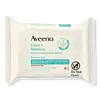What's inside
What's inside
 Key Ingredients
Key Ingredients

No key ingredients
 Benefits
Benefits

 Concerns
Concerns

 Ingredients Side-by-side
Ingredients Side-by-side

Water
Skin ConditioningIsononyl Isononanoate
EmollientPentaerythrityl Tetraethylhexanoate
EmollientCetyl Ethylhexanoate
EmollientIsostearyl Palmitate
EmollientCyclopentasiloxane
EmollientHexylene Glycol
EmulsifyingPEG-6 Caprylic/Capric Glycerides
EmulsifyingPhenoxyethanol
PreservativeParfum
MaskingSucrose Cocoate
EmulsifyingAcrylates/C10-30 Alkyl Acrylate Crosspolymer
Emulsion StabilisingSodium Hydroxide
BufferingPEG-4 Laurate
EmulsifyingBenzoic Acid
MaskingButylene Glycol
HumectantDehydroacetic Acid
PreservativeEthylhexylglycerin
Skin ConditioningIodopropynyl Butylcarbamate
PreservativePolyaminopropyl Biguanide
PreservativeGlycine Soja Protein
EmulsifyingWater, Isononyl Isononanoate, Pentaerythrityl Tetraethylhexanoate, Cetyl Ethylhexanoate, Isostearyl Palmitate, Cyclopentasiloxane, Hexylene Glycol, PEG-6 Caprylic/Capric Glycerides, Phenoxyethanol, Parfum, Sucrose Cocoate, Acrylates/C10-30 Alkyl Acrylate Crosspolymer, Sodium Hydroxide, PEG-4 Laurate, Benzoic Acid, Butylene Glycol, Dehydroacetic Acid, Ethylhexylglycerin, Iodopropynyl Butylcarbamate, Polyaminopropyl Biguanide, Glycine Soja Protein
Water
Skin ConditioningDecyl Isostearate
EmollientIsopropyl Isostearate
EmollientDimethicone
EmollientIsohexadecane
EmollientHexylene Glycol
EmulsifyingPEG-6 Caprylic/Capric Glycerides
EmulsifyingTrisiloxane
Skin ConditioningPhenoxyethanol
PreservativeSucrose Cocoate
EmulsifyingChlorphenesin
AntimicrobialPanthenol
Skin ConditioningPolysorbate 20
EmulsifyingAcrylates/C10-30 Alkyl Acrylate Crosspolymer
Emulsion StabilisingTocopheryl Acetate
AntioxidantSodium Hydroxide
BufferingGlycerin
HumectantChrysanthemum Parthenium Flower/Leaf/Stem Juice
AntioxidantAvena Sativa Kernel Extract
AbrasiveWater, Decyl Isostearate, Isopropyl Isostearate, Dimethicone, Isohexadecane, Hexylene Glycol, PEG-6 Caprylic/Capric Glycerides, Trisiloxane, Phenoxyethanol, Sucrose Cocoate, Chlorphenesin, Panthenol, Polysorbate 20, Acrylates/C10-30 Alkyl Acrylate Crosspolymer, Tocopheryl Acetate, Sodium Hydroxide, Glycerin, Chrysanthemum Parthenium Flower/Leaf/Stem Juice, Avena Sativa Kernel Extract
Ingredients Explained
These ingredients are found in both products.
Ingredients higher up in an ingredient list are typically present in a larger amount.
Acrylates/C10-30 Alkyl Acrylate Crosspolymer is a synthetic polymer. It is used to thicken and improve the texture of products. Due to its properties, it can prevent water and oil ingredients from separating.
Hexylene Glycol is a surfactant. Glycols are a class of alcohols. Hexylene Glycol is a surfactant and emulsifier.
As a surfactant, Hexylene Glycol helps gather dirt and oil on your skin to be washed away.
As an emulsifier, Hexylene Glycol helps keep water and oil together. This prevents them from separating in a product. Hexylene Glycol also thins out the texture of a product by lessening viscosity.
Hexylene Glycol has a small molecular weight.
Learn more about Hexylene GlycolThis ingredient is derived from caprylic and capric acids. It is an emulsifier with emollient properties.
According to the manufacturer, it is hydrophilic and soluble in aqueous solutions (water). They also state this ingredient is stable in a medium pH range (~5 - 8).
As an emulsifier, it helps make oils and oil-soluble ingredients more soluble in water.
Learn more about PEG-6 Caprylic/Capric GlyceridesPhenoxyethanol is a preservative that has germicide, antimicrobial, and aromatic properties. Studies show that phenoxyethanol can prevent microbial growth. By itself, it has a scent that is similar to that of a rose.
It's often used in formulations along with Caprylyl Glycol to preserve the shelf life of products.
Sodium Hydroxide is also known as lye or caustic soda. It is used to adjust the pH of products; many ingredients require a specific pH to be effective.
In small amounts, sodium hydroxide is considered safe to use. However, large amounts may cause chemical burns due to its high alkaline.
Your skin has a natural pH and acid mantle. This acid mantle helps prevent harmful bacteria from breaking through. The acid mantle also helps keep your skin hydrated.
"Alkaline" refers to a high pH level. A low pH level would be considered acidic.
Learn more about Sodium HydroxideSucrose Cocoate is created from the sucrose esters of coconut acid. Coconut acid is comprised of the fatty acids of coconut oil.
It is an emulsifier and skin conditioner.
This ingredient may not be fungal acne safe.
Learn more about Sucrose CocoateWater. It's the most common cosmetic ingredient of all. You'll usually see it at the top of ingredient lists, meaning that it makes up the largest part of the product.
So why is it so popular? Water most often acts as a solvent - this means that it helps dissolve other ingredients into the formulation.
You'll also recognize water as that liquid we all need to stay alive. If you see this, drink a glass of water. Stay hydrated!
Learn more about Water